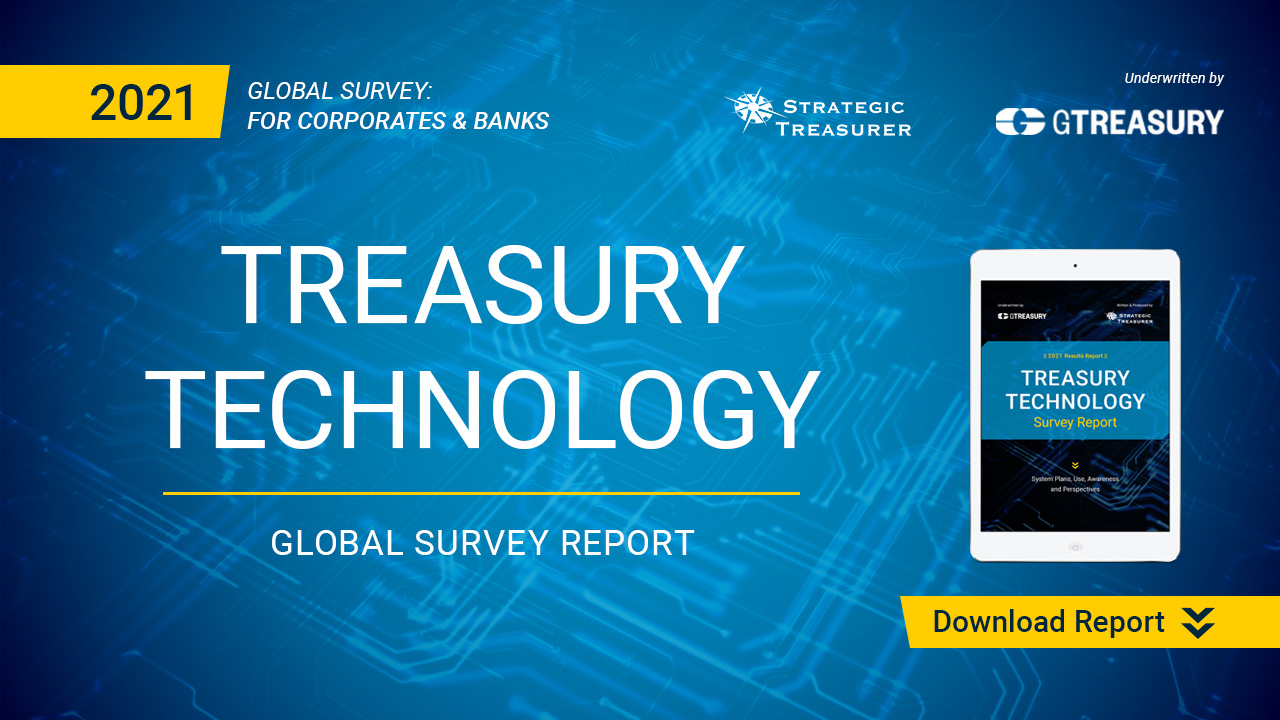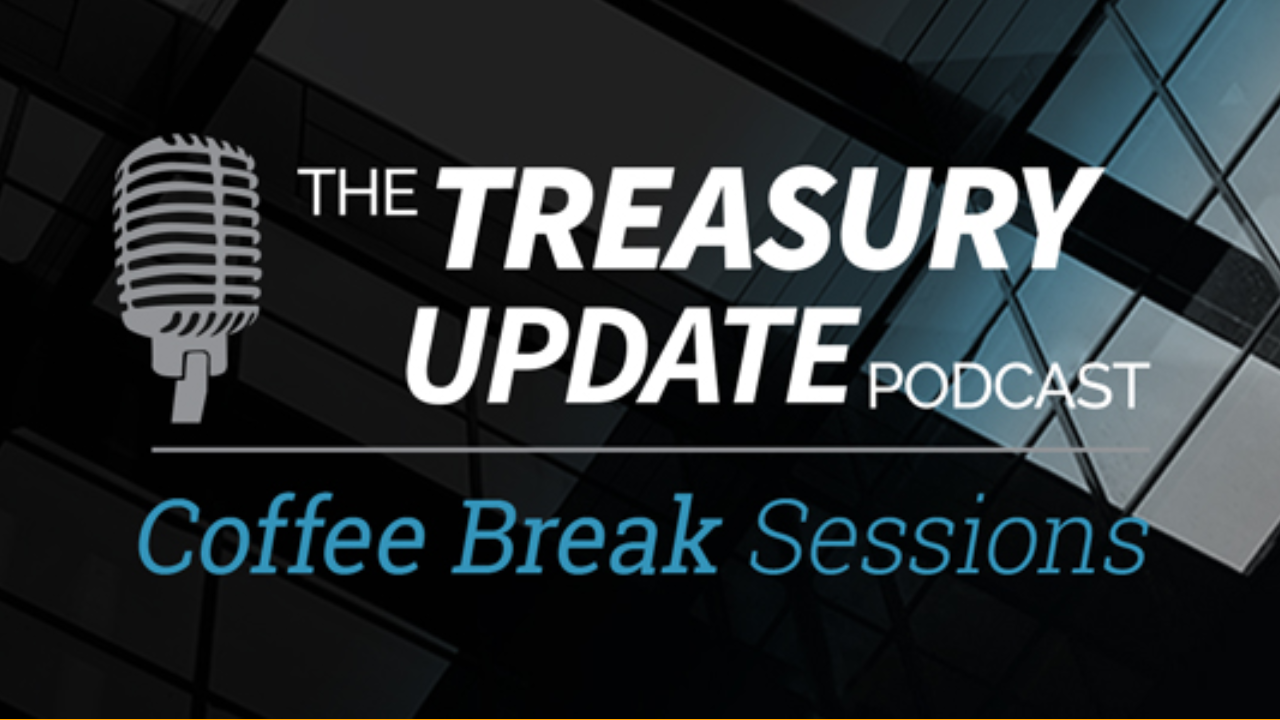
Session 53
Coffee Break Session:
What Is RTP?
Host:
Alexa Cook, Strategic Treasurer


Speaker:
Craig Jeffery, Strategic Treasurer


Episode Transcription - (Coffee Break Session Series) - Episode 53 - What is RTP
Alexa Cook 0:10
Hey guys, welcome to The Treasury Update Podcast Coffee Break Session. The show where we cover foundational treasury topics and questions in about the same amount of time it takes you to drink your coffee. This is your host Alexa and I’m joined today with Craig Jeffery, Managing Partner of Strategic Treasurer. Welcome back, Craig.
Craig Jeffery 0:28
Thanks, Alexa.
Alexa Cook 0:29
Yeah, so today we’re going to cover “What is RTP?” and I will admit, when I was originally writing this up, my Google result of RTP was not the actual topic today. So maybe you could just start us off with what is RTP. What does RTP stand for?
Craig Jeffery 0:44
Well, I think we’re talking about real time payments offered through the clearing house. So, I’m going to go with that one. I mean, acronyms are always a bit of a challenge. But yeah, real time payments are credit push payments to new, one of the new newest payment rails. And it’s been a long time since there’s been new payment rails offered in the US, and it’s through the clearing house and there’s more than 150 financial institutions using it. And RTP payments are like I said, credit payments, they’re credit push, you send payments and the limit is currently $100,000 US.
Alexa Cook 1:23
Since this is a newer type of payment, what are some of the advantages of using RTP?
Craig Jeffery 1:28
A lot of the payment systems whether you think about card, even check the automated clearing house or ACH, or several of the different wire system or real time gross settlement systems that we have in the US, this is one of the newer ones. It seems like every country has one or more faster real time instant payment platforms that exist. One of the key advantages is speed. It’s faster. It’s a, you know, availability of the funds is immediate, like a wire transfer, but it’s also available 24/7. So, it has this whole certainty aspect of it. So, it’s payment certain it’s immediately available, and it’s available all the time. Now there’s a couple other enriched capabilities that come along with it as well. But that’s a start. I can go into some of those other ones as well.
Alexa Cook 2:26
Yeah, so let’s maybe jump to how treasury departments are using it before we do a deeper dive.
Craig Jeffery 2:32
There are two primary ways companies tend to use this one is for these urgent payments, to oftentimes to consumers. The limit is $100,000. So, it’s not tiny. It’s not, you know, $1,000 or $10,000. But it’s not really up to snuff if you’re looking to send $10 million you, you’d have to send quite a few separate RTPs to make that work. So, for these urgent payments, they work well it could be making a claims payment from insurance company or if you need to catch someone up for payroll. You wouldn’t have to use a wire you could use a real-time payment. So, smaller fund movements work. That tends not to be a treasury use. The treasurer may support that. But there are treasury departments that are using it for cash mobilization, certain accounts that don’t have huge sums in them, but they can use this to push money around to their concentration banks and accounts using this as part of their platform.
Alexa Cook 3:41
So then, what are some of the other features or advantages really using this newer platform?
Craig Jeffery 3:47
Yeah, so we already mentioned it’s available 24/7 which is a pretty significant change, you know, versus these batch-oriented systems or overnight oriented systems. So, you think of the ACH network that was always a batch overnight platform. Well, now there’s same day ACH, which I think now we’re at, there’s four windows a day where payments can still batch, same rails, certainly faster at multiple times a day, but RTP is in a real time. And this activity can occur, you know, anytime any day of the week. The other aspect I think is worth noting there’s quite a few items they refer to it is extensibility, and this is how you can include messaging function, messaging functionality, messaging detail, when you’re sending payments from a business standpoint. There’s other information, business documents as it were, that need to travel along with it. So, this allows yourself bill sent bills or invoices, transaction details along with the payment so they arrive together. So, it’s you know, referred to as extensible. The money comes with information. So, value comes with valuable information. That’s another key aspect of this real-time payment network. I think the other aspect is we don’t have to wait for because it’s real-time, because it’s 24/7 there’s no, “Oh I’ve got to wait for this period of time before this other event or activity can be enacted”. This is the original waterfall event from which all the other ones flow from. I don’t have to wait. It comes in next step. And the next step without this time delay or this float of time. I think that’s really, really important for what we see in a new payment platform and RTP meets the I believe there’s like 37 or 39 elements of real-time or an instantaneous payment platform and RTP has characteristics for all of those. So, those are those are some of the biggest elements of RTP. And there’s certainly value in moving funds faster, moving information with the value transfer, so, everything from reconciliation to settlement to easing the friction in business activity.
Alexa Cook 6:34
That’s great. I like the way that you put that easing the friction. So, then just to do a quick recap of it. RTP is real-time payments. It’s a newer payment, I guess platform that’s from via the clearing house. It is only a credit push and currently the limits about 100,000 but it is 24 hours a day. So that’s the newer piece of it.
Craig Jeffery 6:55
Well, I think you summarized that. Well though. The one thing I would add, particularly for those who may not be familiar with US banking. You know many in many countries, the central bank acts as the clearing house whether it’s for RTGS, wire payments, ACH are the EFT type payments. These are oftentimes managed and clear through the central bank. The US has at least two payment settlement systems or messaging systems or platforms. Usually, one is run through the Fed or through entities controlled by the Fed Federal Reserve. And then there’s some private type of ownership owned by the banks. So, the clearing house is owned by member banks. And they do image settlement, other types of activities you can handle other types of transactions through the clearing house as a as a separate way of doing things. You can clear through NACHA; you can clear through the clearing house. You’ve got multiple ways of settling the same type of transactions, RTGS wires, etc. And so, this is a new this is not an alternative channel to a Fed platform. It’s a new payment rail that they manage. And it’s also interesting that the Fed is rolling out FedNow as another urgent instantaneous payment mechanism and vehicle.
Alexa Cook 8:31
That’s great. It sounds like that FedNow might have to be another topic for us to discuss on this.
Craig Jeffery 8:37
It is that we could talk it we can do another one on same day ACH if we haven’t covered that already.
Alexa Cook 8:41
Yeah. That’s great. Thanks for adding those on Craig. And thanks for joining me today and to all our listeners make sure you tune in every first and third Thursday of the month for a new Coffee Break Session. And as always, we love hearing from you. So, if you have any questions, comments, or just want to say hi, you can send us an email at podcast@strategictreasurer.com. Thanks again, Craig.
Strategic Treasurer and GTreasury are proud to present the findings from the Treasury Technology Survey with data from over 250 respondents operating primarily across North America and Europe. This annual study polls treasury and finance professionals on their views regarding the technology drivers and challenges and system plans, use, and needs.




